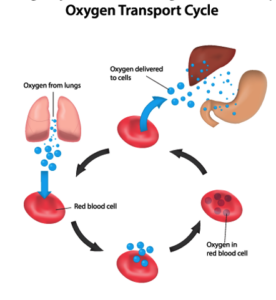Energy is everything – without it nothing would survive. A phrase taken out of what could be a documentary on the universe also rings true for the universe inside of us. Think about this for a second. We have approximately 32 TRILLION cells in our body, with each cell containing about 2000 mitochondria on average. My math tells me that is a big number and what do EACH of those little power houses need to function well? Oxygen.
“All disease is just a complex manifestation of an energy problem gone on too long.”
The fundamental reason we breathe is so oxygen can accept the final electron within the mitochondrial ATP production process, so our food can be turned into energy and the byproducts of said metabolism (carbon dioxide & water) can be generated and processed appropriately. All disease is just a complex manifestation of an energy problem gone on too long. By understanding this we can put the pieces together.
-
-
- To be healthy we need to have strong metabolic function (energy metabolism)
- To have strong energy metabolism we need to carry oxygen to our cells
- To carry oxygen to our cells we need to ensure we breathe well
-
This last piece is really a simple concept that has a lot attached to it. To get more of a clear picture we need to merge the first category of energy metabolism with the second category, Autonomic Nervous System Regulation.
In my opinion, the autonomic nervous system is one of the most important aspects of human physiology to understand when it comes to systemic health. Why you ask? Well, it’s simple, it plays the role of conductor of the behavior of every major organ in the body. It takes signals from the brain and sends them out to organs in a way that ideally is integrative and supportive of optimal health. It is separated into 2 mirrored systems, Sympathetic (fight, flight, flee) and Parasympathetic (rest, recover, digest).
As you can see, the overall roles these systems play seem to be opposite, but the reality is they are integrative in ALL that they do. We need some sympathetic involvement to help our body’s response to input stresses (raising blood pressure when we move from sitting to standing as to not faint) and we need the parasympathetic system to bring our blood pressure back to a healthy normal once we have adjusted to stress. As we look at respiration, each branch of the system has its involvement as follows:
Breathing in: sympathetic influence which elevates heart rate and encourages the movement of oxygen-rich blood to be sent to our tissues.
Breathing out: parasympathetic influence which slows heart rate and allows for a proper rate of exhalation of carbon dioxide to rebalance blood gas levels.
This beautiful yin/yang dance is how we regulate breathing rhythm and maintain things like healthy energy metabolism. See the integration there? There is little consideration we must put forth, however, a small detail we could call a symptom of modern life means we may not maintain this balance very often. Any and all stresses push the body into predominance of sympathetic activation which has a cascade of downstream consequences.
- Increased heart rate
- Increased respiratory rates
- Lack of proper breathing mechanics
- Imbalanced blood O2/CO2 levels
With the nervous system, sustainment means entrainment. The more we stay in the sympathetic, the less seamlessly we can engage to provide balance, and our health suffers. If we become aware of this and try to do something about it, we may do so in an intense way and try to force breathing that is deep and unnatural. Furthermore, we may encounter one last issue we may be ignorant of. By trying to help ourselves breathe deeply, we may further compound the problem unless we understand the aspect of respiratory fitness known as Gas Exchange.
Regarding this concept it’s more about understanding the fundamentals of what NOT to do if you’ve been thinking you want to start entraining your respiration. We have all heard that to relax we must breathe deeply; we are even told to “take a breath” when we are agitated – as some offer this quick advice thinking it helps. Though stated with good intentions it might make the person worse. How could this be? Well, it’s quite simple in biochemical essence. We are meant to breathe through our noses as this both warms and filters the air. It also regulates the volume of air flowing in and out which our bodies rely upon to regulate the ratio of oxygen to carbon dioxide in our blood.
If we were to change this by taking a breath in through the nose and out through the mouth, what would happen? On the surface it just looks like we wanted to force more air out. Well, what just happened was we took in a certain amount of oxygen through the nose and pushed out WAY more carbon dioxide through the mouth. This may not sound like a big deal or might even sound like a good thing, but under the surface, your body has other ideas. How we release oxygen is determined by the amount of carbon dioxide in the blood. If we blow out all our CO2 via a large exhalation through the mouth, we have low blood CO2 and now our bodies will hold on to more oxygen. What else happens within the cascade? Our energy metabolism becomes compromised because we are NOT using that oxygen to make ATP, our bodies enter a fight or flight (sympathetic) state, and we feel even more stressed all because we followed the advice of “breathing deeply” without understanding HOW to do it or what may happen if we don’t do so properly.
There is so much more we could get into with breathing. I recommend exploring this topic further in the book, The Thyroid Debacle which has a chapter dedicated to this very topic. To round this discussion, I’m going to share what I feel are key concepts to improving respiratory fitness starting tomorrow.
- Clean the air in your space
Use a HEPA filter in your home, vacuum regularly, throw away air fresheners, use cleaning products scented with essential oils, open your windows daily, and keep your HVAC system well maintained. This will reduce the need for your nose to filter out so many airborne particles AND stop you from inhaling toxins you can’t see! What use is working on breathing if you are breathing in crappy air?! - Make a Point to Practice Mindful Breathing
The process of breathing in and out is autonomous and as such will happen if you think about it or not, which is great for not passing out. However, if your current breathing rhythm is not ideal, changing it takes conscious work. That is why before learning how to modify your breathing you need to commit to the mental process of doing so or else like many other health practices it will be a fly-by-night thing. It must be a commitment to change that moves from a behavior into a habit so that no matter what you are doing, it will become your default way of breathing. You could find your future-self watching a movie and involuntarily breathing through your diaphragm having never done that before!
“…before learning how to modify your breathing you need to commit to the mental process of doing so”
- Check Your Respiratory Fitness
Most people would be shocked to figure out how poorly their body oxygenates itself. Luckily you can get a sense of this based on how long you can stretch a single breath. Here’s how. Upon taking a small exhalation, take a normal inhalation through your nose and pinch it as you start a timer. Hold your breath until you get the FIRST inclination to breathe, not to where you are flailing to hold your breath as long as you can. Your goal should be 40sec or more which I found myself to be shy of the first time I tried it. If you are below 20sec you have some work to do. - Begin Your Training
This part is where I don’t have specific guidance for you because there isn’t one way to improve your respiratory fitness. What I can say is that there are some great starting points out there like box breathing, meditation-style breathing, yoga, or possibly hiring a breath work coach if that is appropriate. What I can say is that when you are doing dedicated practice, first set your environment to where your nervous system is able to relax. ALWAYS breathe in and out through your nose. Breathe with intention to breathe into your belly and diaphragm (not your chest) and extend the breathing out as long and slow as possible. If you can get to the point where you are taking 6-10 breaths per minute, you’re making great progress. Breathe well my friends.
Shared with permission from Master Supplements & U.S. Enzymes
Roland Pankewich is an Education Specialist and Clinical Health Consultant with Master Supplements Inc. (U.S. Enzymes). He focuses on the clinical practice of health optimization, utilizing a framework that detects and corrects nutritional deficiencies, subtle toxicities, and excesses at a biochemical level. His clients are those who wish to optimize their health and performance and do so without a disease-focused model. Through functional lab testing, and utilizing the Master Philosophy he teaches to other health care providers, Roland personalizes interventions in a client-defined way working together to restore the inherent signals of the body that restore optimal function. The philosophy of this framework extends from deep understanding of biochemistry, anatomy, and physiology which he utilizes in education and lectures to professionals in the health and wellness field.







